Table of Contents

Water Weight Calculator (by Unit of Volume & Temperature)
Note that water is at maximum density (or weight per unit of volume) at 39.2°F/4.0°C. The weight of water is usually given for water at maximum density by default, but we are using room temperature (70°F) as the default setting.
If you select a temperature other than 39.2°F/4.0°C, the weight values calculated will likely be slightly different than water weight values found elsewhere.
As water temperature deviates from 39.2°F (4.0°C), it expands slightly, reducing its density. This means that at higher temperatures, a given volume of water will weigh slightly less.
This calculator assumes pure freshwater. If dealing with saltwater, density (and thus weight) will be higher due to dissolved salts.
Water Weight Calculator
Unit & Temperature
Result
Water Weight Calculator (by Area and Depth)
Water Weight Calculator
By Area and Depth
Result
How to Calculate the Weight of Water
To find the weight of water, you need to pick which unit of volume you want to use to measure the water, and then figure out how many of these units your quantity of water contains. All of the most common units of volume are included in Table 1 below.
Once you know the type of unit and the number of units, refer to the weight of your unit given in Table 1, and multiply the weight for one of those units by the number of units you have.
Next, you need to adjust the weight to account for the temperature of the water.
The weights given in Table 1 are for water at maximum density, which water achieves at 39.2°F (or 4°C). The density of water changes with temperature, meaning the weight of a fixed volume of water (such as a gallon) also varies slightly with temperature.
For small quantities of water, the effect of temperature is negligible for practical purposes. For large volumes, especially in scientific, engineering, or industrial applications, adjusting for temperature is important to ensure accuracy.
Table 2 below shows water density by temperature, and the second column in the table shows the percentage of maximum density for each temperature. You can select your temperature and see what percentage of maximum density it is.
Since the weight value from Table 1 is based on maximum density, you can adjust for temperature by multiplying that value by the percentage value from Table 2, which represents how close the actual density is to maximum density at your selected temperature.
While temperature is one key factor affecting water density, extreme altitude or pressure can also have minor effects. If precision is critical, consult specialized density tables that account for these variables.
Example:
How much does 100 gallons of water weigh at room temperature?
Step 1:
According to Table 1, a gallon of water weighs 8.34540 pounds at maximum density.
Step 2:
8.34540 × 100 = 834.54 pounds
100 gallons of water weighs 834.54 pounds at maximum density.
Step 3:
According to Table 2, the density of water at room temperature (70°F) is 99.802% of the density of water at 39.2°F (maximum density).
Multiply 834.54 pounds by 0.99802 to get 832.8876108 pounds, which we would round off to 832.89 pounds.
The final weight is rounded to two decimal places, but the level of rounding can be adjusted depending on the required precision.
So, 100 gallons of water weighs 832.89 pounds at room temperature.
Weight of Water by Unit of Volume and Temperature
Weight of Water and Temperature
At room temperature (I’m assuming room temperature to be 70°F or 21°C), the density of water is approximately 0.00198 g/cm³ lower than its maximum density at 39.2°F (4.0°C) (see the next table below).
You can figure that the weight of water at room temperature for any specific volume will be approximately 99.8 percent of the weight of the same volume of water at 39.2°F (4.0°C). For example, a cubic foot of water at room temperature will weigh 62.3044 lbs., which is approximately 99.8% of the 62.4280 lbs. that a cubic foot of water weighs at 39.2°F (4.0°C).
As water warms beyond 39.2°F (4.0°C), it expands slightly, decreasing its density and reducing its weight per unit volume. Conversely, cooling water causes slight contraction until it nears freezing, at which point it expands again.
These tables provide values for pure water; real-world water sources may contain dissolved minerals or impurities that slightly alter density and weight. In industrial or scientific applications, additional adjustments may be necessary to account for these factors.
I’m aware that a mole of water is a specific number of water molecules and not a unit of volume, but I thought I’d include it anyway. A mole of water refers to Avogadro’s number of water molecules (approximately 6.022 × 10²³ molecules), which corresponds to 18.015 grams of pure water. At 39.2°F (4.0°C), where water is at maximum density (1 g/cm³), one mole of water has a volume of approximately 18.015 mL (or cm³).
Note: A fluid ounce is a unit of volume, not weight. The weight of a fluid ounce of water varies depending on temperature and density.
Table 1: Weight of Water by Unit of Volume
This table gives the weight of water per unit for all of the common measurement units used to measure liquid volume. The weight values provided are for pure water at maximum density, which occurs at 39.2°F (4.0°C) under standard atmospheric pressure (1 atm).
| Weight of Water for All Common Units of Volume Measurement | ||||||
|---|---|---|---|---|---|---|
| (Weight of water at maximum density. Water is at maximum density at 39.2°F or 4°C.) | ||||||
| Unit of Volume | Abbreviation | Same Volume in Milliliters | Weight of Water in Pounds | Weight of Water in Ounces | Weight of Water in Kilograms | Weight of Water in Grams |
| Centiliter | cl, cL | 10 mL | 0.02205 lb | 0.35274 oz | 0.01 kg | 10 g |
| Cubic Centimeter | cm³, cc, ccm | 1 mL | 0.00220 lb | 0.03527 oz | 0.001 kg | 1 g |
| Cubic Foot | ft³, cu ft | 28,316.8 mL | 62.42786 lb | 998.84573 oz | 28.3168 kg | 28,316.8 g |
| Cubic Inch | in³, cu in | 16.3871 mL | 0.03613 lb | 0.57804 oz | 0.01639 kg | 16.3871 g |
| Cubic Meter | m³ | 1,000,000 mL | 2,204.62 lb | 35,273.96 oz | 1,000 kg | 1,000,000 g |
| Cubic Yard | yd³, cu yd | 764,555 mL | 1,685.56 lb | 26,968.88 oz | 764.555 kg | 764,555 g |
| Cup (Imperial) | C, c | 284.131 mL | 0.62640 lb | 10.02243 oz | 0.28413 kg | 284.131 g |
| Cup (Metric) | C, c | 250 mL | 0.55116 lb | 8.81849 oz | 0.25 kg | 250 g |
| Cup (U.S. Customary) | C, c | 236.58824 mL | 0.52159 lb | 8.34540 oz | 0.23659 kg | 236.58824 g |
| Cup (U.S. Legal) | C, c | 240 mL | 0.52911 lb | 8.46575 oz | 0.24 kg | 240 g |
| Deciliter | dl, dL | 100 mL | 0.22046 lb | 3.5274 oz | 0.1 kg | 100 g |
| Drop (Pharm.) | gt, gtt | 0.05 mL | 0.00011 lb | 0.00176 oz | 0.00005 kg | 0.05 g |
| Fluid Dram (U.S.) | fl dr, fʒ | 3.69669 mL | 0.00815 lb | 0.13040 oz | 0.00370 kg | 3.69669 g |
| Fluid Ounce (U.S.) | fl oz, f℥ | 29.5735 mL | 0.06520 lb | 1.04317 oz | 0.02957 kg | 29.5735 g |
| Gallon (U.S.) | gal | 3,785.41 mL | 8.34540 lb | 133.52641 oz | 3.78541 kg | 3,785.41 g |
| Half Gallon | 1/2 gal | 1892.71 mL | 4.17271 lb | 66.76338 oz | 1.89271 kg | 1892.71 g |
| Liter | l, L | 1,000 mL | 2.20462 lb | 35.274 oz | 1 kg | 1,000 g |
| Milliliter (ml) | ml, mL | 1 mL | 0.00220 lb | 0.03527 oz | 0.001 kg | 1 g |
| Minim (U.S.) | min, ♏︎ | 0.06161 mL | 0.00014 lb | 0.00217 oz | 0.00006 kg | 0.06161 g |
| Mole | mol | N.A. | 0.03972 lb | 0.63547 oz | 0.01802 kg | 18.01528 g |
| Pint (U.S.) | pt, p | 473.176 mL | 1.04317 lb | 16.69079 oz | 0.47318 kg | 473.176 g |
| Quart (U.S.) | qt | 946.353 mL | 2.08635 lb | 33.38162 oz | 0.94635 kg | 946.353 g |
| Tablespoon (U.S.) | tbsp, T | 14.7868 mL | 0.03260 lb | 0.52159 oz | 0.01479 kg | 14.7868 g |
| Teaspoon (U.S.) | tsp, t | 4.92892 mL | 0.01087 lb | 0.17386 oz | 0.00493 kg | 4.92892 g |
Table 2: Density of Water by Temperature
| Water Density by Temperature | |||||
|---|---|---|---|---|---|
| Temperature °F/°C |
Density as Percentage of Maximum Density | Pounds per Cubic Foot lb/ft³ |
Pounds per Cubic Inch lb/in³ |
Kilograms per Cubic Meter kg/m³ |
Grams per Cubic Centimeter g/cm³ |
| 32°F/0°C | 99.987% | 62.4198 lb/ft³ | 0.03612 lb/in³ | 999.87 kg/m³ | 0.99987 g/cm³ |
| 39.2°F/4.0°C | 100% | 62.4280 lb/ft³ | 0.03613 lb/in³ | 1,000 kg/m³ | 1.00000 g/cm³ |
| 40°F/4.4°C | 99.999% | 62.4273 lb/ft³ | 0.03613 lb/in³ | 999.99 kg/m³ | 0.99999 g/cm³ |
| 50°F/10°C | 99.975% | 62.4124 lb/ft³ | 0.03612 lb/in³ | 999.75 kg/m³ | 0.99975 g/cm³ |
| 60°F/15.6°C | 99.907% | 62.3699 lb/ft³ | 0.03609 lb/in³ | 999.07 kg/m³ | 0.99907 g/cm³ |
| 70°F/21°C | 99.802% | 62.3044 lb/ft³ | 0.03606 lb/in³ | 998.02 kg/m³ | 0.99802 g/cm³ |
| 80°F/26.7°C | 99.669% | 62.2213 lb/ft³ | 0.03601 lb/in³ | 996.69 kg/m³ | 0.99669 g/cm³ |
| 90°F/32.2°C | 99.510% | 62.1221 lb/ft³ | 0.03595 lb/in³ | 995.10 kg/m³ | 0.99510 g/cm³ |
| 100°F/37.8°C | 99.318% | 62.0022 lb/ft³ | 0.03588 lb/in³ | 993.18 kg/m³ | 0.99318 g/cm³ |
| 120°F/48.9°C | 98.870% | 61.7225 lb/ft³ | 0.03572 lb/in³ | 988.70 kg/m³ | 0.98870 g/cm³ |
| 140°F/60°C | 98.338% | 61.3904 lb/ft³ | 0.03553 lb/in³ | 983.38 kg/m³ | 0.98338 g/cm³ |
| 160°F/71.1°C | 97.729% | 61.0102 lb/ft³ | 0.03531 lb/in³ | 977.29 kg/m³ | 0.97729 g/cm³ |
| 180°F/82.2°C | 97.056% | 60.5901 lb/ft³ | 0.03506 lb/in³ | 970.56 kg/m³ | 0.97056 g/cm³ |
| 200°F/93.3°C | 96.333% | 60.1387 lb/ft³ | 0.03480 lb/in³ | 963.33 kg/m³ | 0.96333 g/cm³ |
| 212°F/100°C | 95.865% | 59.8466 lb/ft³ | 0.03463 lb/in³ | 958.65 kg/m³ | 0.95865 g/cm³ |
Water Weight per Inch per Square Foot (for Ponding Water)

The table below provides the weight of water per inch in pounds for various areas/square footages. This should allow you to quickly and accurately estimate the weight of any amount of standing water on your low-slope roof. (I obviously wrote this section before I added the calculators to this web page).
One cubic inch of water weighs approximately 0.036127 pounds at maximum density (39.2°F / 4.0°C). At room temperature (70°F / 21°C), it will weigh slightly less due to its slightly reduced density. Since one square foot of water one inch deep contains 144 cubic inches of water, its weight is 144 × 0.036127 = 5.202288 pounds at maximum density. Everything else in the table has been calculated from this.
This table should give you an idea of how much weight a rain load could be imposing on your roof due to areas of ponding water or clogged drains. For practical roofing calculations, this slight variation in weight due to temperature is usually negligible, but for large roof areas or engineering assessments, it may be worth considering.
Keep in mind that prolonged ponding water can significantly increase roof stress, leading to structural damage or failure if drainage issues are not addressed. Always compare estimated water weight with the roof’s design load capacity to ensure safety. Also, see my roof drainage article for more about ponding water.
Weight of water values for areas or depths not covered in the table should be easy to figure out simply by adding together values for areas or depths that are listed.
Table 3: Weight of Water per Inch per Square Foot
| Weight of Water per Inch per Square Foot in Pounds | |||||||||||
|---|---|---|---|---|---|---|---|---|---|---|---|
| Depth of Water in Inches |
Surface Area of Water in Square Feet | ||||||||||
| ↓ | 1 Square Foot |
2 Square Feet |
3 Square Feet |
5 Square Feet |
10 Square Feet |
20 Square Feet |
30 Square Feet |
50 Square Feet |
100 Square Feet |
500 Square Feet |
1000 Square Feet |
| 0.25 inch | 1.30 lbs. |
2.60 lbs. |
3.90 lbs. |
6.50 lbs. |
13.01 lbs. |
26.01 lbs. |
39.02 lbs. |
65.03 lbs. |
130.06 lbs. |
650.29 lbs |
1,300.57 lbs. |
| 0.5 inch | 2.60 | 5.20 | 7.80 | 13.01 | 26.01 | 52.02 | 78.03 | 130.06 | 260.11 | 1,300.57 | 2,601.14 |
| 1 inch | 5.20 | 10.41 | 15.61 | 26.01 | 52.02 | 104.05 | 156.07 | 260.11 | 520.23 | 2,601.14 | 5,202.29 |
| 2 inches | 10.41 | 20.81 | 31.21 | 52.02 | 104.05 | 208.09 | 312.14 | 520.23 | 1,040.46 | 5,202.29 | 10,404.58 |
| 3 inches | 15.61 | 31.21 | 46.82 | 78.03 | 156.07 | 312.14 | 468.21 | 780.34 | 1,560.69 | 7,803.43 | 15,606.86 |
| 4 inches | 20.81 | 41.62 | 62.43 | 104.05 | 208.09 | 416.18 | 624.27 | 1,040.46 | 2,080.92 | 10,404.58 | 20,809.15 |
| 5 inches | 26.01 | 52.02 | 78.03 | 130.06 | 260.11 | 520.23 | 780.34 | 1,300.57 | 2,601.14 | 13,005.72 | 26,011.44 |
| 6 inches | 31.21 | 62.43 | 93.64 | 156.07 | 312.14 | 624.28 | 936.41 | 1,560.69 | 3,121.37 | 15,606.86 | 31,213.73 |
| 7 inches | 36.42 | 72.83 | 109.25 | 182.08 | 364.16 | 728.32 | 1,092.48 | 1,820.80 | 3,641.60 | 18,208.01 | 36,416.02 |
| 8 inches | 41.62 | 83.24 | 124.86 | 208.09 | 416.18 | 832.37 | 1,248.55 | 2,080.92 | 4,161.83 | 20,809.15 | 41,618.30 |
| 9 inches | 46.82 | 93.64 | 140.46 | 234.10 | 468.21 | 936.41 | 1,404.62 | 2,341.03 | 4,682.06 | 23,410.30 | 46,820.59 |
| 10 inches | 52.02 | 104.05 | 156.07 | 260.11 | 520.23 | 1,040.46 | 1,560.69 | 2,601.14 | 5,202.29 | 26,011.44 | 52,022.88 |
| 11 inches | 57.23 | 114.45 | 171.68 | 286.13 | 572.25 | 1,144.50 | 1,716.76 | 2,861.26 | 5,722.52 | 28,612.58 | 57,225.17 |
| 12 inches | 62.43 | 124.86 | 187.28 | 312.14 | 624.28 | 1,248.55 | 1,873.04 | 3,121.37 | 6,242.75 | 31,213.73 | 62,427.46 |
| 24 inches | 124.86 | 249.71 | 374.57 | 624.28 | 1,248.55 | 2,497.10 | 3,745.65 | 6,242.75 | 12,485.49 | 62,427.46 | 124,854.91 |
| 36 inches | 187.28 | 374.57 | 561.85 | 936.41 | 1,872.82 | 3,745.65 | 5,618.47 | 9,364.12 | 18,728.24 | 93,641.18 | 187,282.37 |
| 48 inches | 249.71 | 499.42 | 749.13 | 1,248.55 | 2,497.10 | 4,994.20 | 7,491.29 | 12,485.49 | 24,970.98 | 124,854.91 | 249,709.82 |
| 60 inches | 312.14 | 624.28 | 936.41 | 1,560.69 | 3,121.37 | 6,242.75 | 9,364.12 | 15,606.86 | 31,213.73 | 156,068.64 | 312,137.28 |

